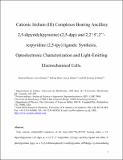Cationic iridium(III) complexes bearing ancillary 2,5-dipyridyl(pyrazine) (2,5-dpp) and 2,2 ':5 ',2 ''-terpyridine (2,5-tpy) ligands : synthesis, optoelectronic characterization and light-emitting electrochemical cells
Abstract
Four cationic iridium(III) complexes of the form [Ir(C^N)2(N^N)]+ bearing either a 2,5-dipyridylpyrazine (2,5-dpp) or a 2,2′:5′,2′′-terpyridine (2,5-tpy) ancillary ligand and either 2-phenylpyridine (ppy) or a 2-(2,4-difluorophenyl)-5-methylpyridine (dFMeppy) cyclometalating ligands were synthesized. The optoelectronic properties of all complexes have been fully characterized by UV-visible absorption, cyclic voltammetry and emission spectroscopy. The conclusions drawn from these studies have been corroborated by DFT and TDDFT calculations. The four complexes were assessed as emitters in light-emitting electrochemical cells. Complex 1a, [Ir(ppy)2(2,5-dpp)]PF6, was found to be a deep red emitter (666 nm) both in acetonitrile solution and in the electroluminescent device. Complex 2a, [Ir(ppy)2(2,5-tpy)]PF6 was found to be an orange emitter (604 nm) both in solution and in the LEEC. LEECs incorporating both of these complexes were stable over the course of around 4–6 hours. Complex 1b, [Ir(dFMeppy)2(2,5-dpp)]PF6, was also determined to emit in the orange (605 nm) but with a photoluminescent quantum yield (ΦPL) double that of 2a. Complex 2b, [Ir(dFMeppy)2(2,5-tpy)]PF6 is an extremely bright green emitter (544 nm, 93%). All four complexes exhibited quasireversible electrochemistry and all four complexes phosphoresce from a mixed charge-transfer excited state.
Citation
Hasan , K , Donato , L , Shen , Y , Slinker , J D & Zysman-Colman , E 2014 , ' Cationic iridium(III) complexes bearing ancillary 2,5-dipyridyl(pyrazine) (2,5-dpp) and 2,2 ':5 ',2 ''-terpyridine (2,5-tpy) ligands : synthesis, optoelectronic characterization and light-emitting electrochemical cells ' , Dalton Transactions , vol. 43 , no. 36 , pp. 13672-13682 . https://doi.org/10.1039/c4dt02100b
Publication
Dalton Transactions
Status
Peer reviewed
ISSN
1477-9226Type
Journal article
Collections
Items in the St Andrews Research Repository are protected by copyright, with all rights reserved, unless otherwise indicated.

